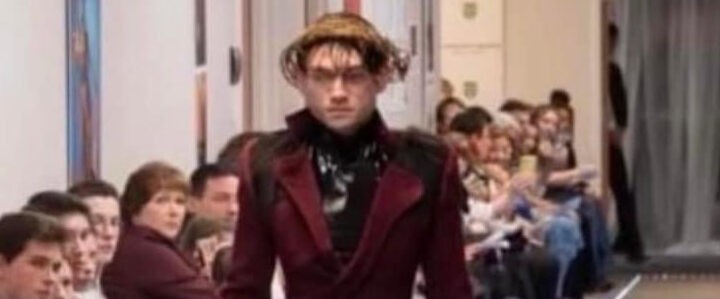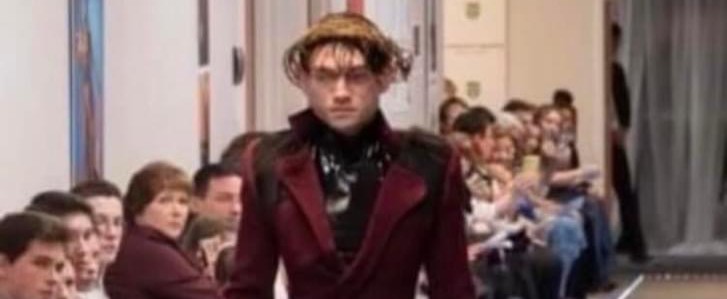Let’s call this controversy Wrap-Coat-Gate.
Trustees and administrators at Bob Jones University recently grew so alarmed over a wrap coat designed by a student for a class project that they publicly called the student’s work sacrilegious, blasphemous, dishonoring to Jesus, offensive, and egregious.
While controversies such as this may appear to spin out of nowhere, they do not. Given the history and perspectives that have been woven into the fabric of BJU for decades, it was only a matter of time before a student in the fashion design department would pull the wrong strings.
Like many Christian institutions, BJU believes all human creativity is a reflection of God’s creativity. Within this framework, the way an artist understands creation will affect the way that artist creates.
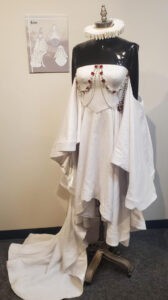
Student fashion design representing a saint
The school’s emphasis on creation over the past century has led it to develop a robust department of fine arts that influences everyone on campus. Students attend operas and Shakespearean plays and have access to more than 100 fine arts programs every year.
One program BJU offers that is unique among Christian universities in the Eastern United States is the bachelor of science degree in fashion design. The website explains: “God is the source of all beauty, the Giver of good gifts to mankind — even the gift of beautiful clothing. At BJU you’ll learn how having a right view of God informs your values and daily decisions, and gives you the motivation to create beautiful and useful apparel. … You’ll learn how God’s character, including His creativity, holiness and goodness, can energize you in your field as you create attractive and modest clothing for His glory.”
Bob Jones University’s view of creation
Before we get to the details of Wrap-Coat-Gate, we must address the view of creation espoused by BJU.
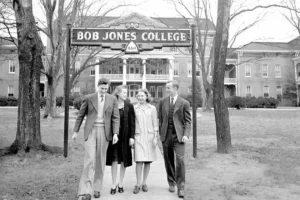 One year before he became involved with the famous Scopes trial, which was a showdown between evolutionists and creationists in 1925 over teaching evolution in public schools, the former United States Secretary of State William Jennings Bryan told Bob Jones Sr., “If schools and colleges do not quit teaching evolution as a fact, we are going to become a nation of atheists.” So in 1927, Bob Jones College opened as a young earth creationist alternative to evolutionary views of creation out of fear of a hypothetical future society created and controlled by atheists.
One year before he became involved with the famous Scopes trial, which was a showdown between evolutionists and creationists in 1925 over teaching evolution in public schools, the former United States Secretary of State William Jennings Bryan told Bob Jones Sr., “If schools and colleges do not quit teaching evolution as a fact, we are going to become a nation of atheists.” So in 1927, Bob Jones College opened as a young earth creationist alternative to evolutionary views of creation out of fear of a hypothetical future society created and controlled by atheists.
BJU teaches that the creation story of Genesis 1 is a clear revelation of God creating the entire universe in six literal 24-hour days, approximately 6,000 years ago.
They also believe Genesis 1 sets up a pattern in creation of the distinctions of pairs: the heavens and the earth, day and night, waters below and waters above, the earth and seas, the greater and lesser light, the fish and birds, the animals and humans, and ultimately male and female.
BJU teaches that these distinctions in creation are God’s creative expression of God’s holiness, which they define as God’s distinction and separation, and which they believe is God’s primary characteristic.
Two of the most notable ways BJU has lived out this distinction principle throughout their history have been through teaching racial distinctions of segregation and gender distinctions of complementarianism.
The created order of segregation
Camille Lewis, who was a professor at BJU for 15 years and has written multiple books about the history of BJU and separatism, uncovered an Easter Sunday sermon from Bob Jones Sr., in which Jones was reacting in 1960 against a Billy Graham trip to Africa where Graham had organized integrated events at which he preached against apartheid.
After Jones’ surprise announcement on CNN, BJU told its students that they could date students of other races only if they received written permission from their parents.
In his sermon, Jones said that “God set up the order of Paradise” with Adam and Eve.
Then Jones applied his created order theology by promoting the distinction of race through segregation:
“White people have helped the colored people build their churches, and we have gotten along together harmoniously and peacefully; and everything has come along fine. Sometimes we have a little trouble, but then we adjust everything sensibly and get back to the established order. … There is an effort today to disturb the established order. … God never meant to have one race. … God has a purpose for each race. … Wherever we have the races mixed up in large numbers, we have trouble. If we would just listen to the word of God and not try to overthrow God’s established order, we would not have any trouble. When someone goes to overthrowing his established order … that makes me sick — for a man to stand up … and talk about rubbing out the line between the races — I say it makes me sick.”
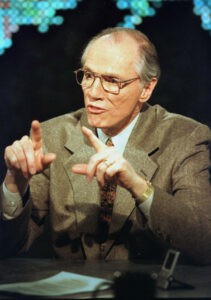
Bob Jones III appears on CNN’s Larry King Live on March 3, 2000.
Interracial dating was banned at BJU up until 2000, when the media began criticizing George W. Bush for giving a campaign speech at BJU. Bob Jones III went on Larry King Live claiming persecution from the media. And when King asked Jones why BJU prohibits interracial dating, Jones explained, “We don’t let them date because … we stand against the one world government, against the coming world of anti-Christ, which is a one world system of blending of all differences.”
Despite his self-justification, Jones tried to spin the school’s decades-long ban on interracial dating as “insignificant” and “unimportant.” And when King asked him, “Don’t you think (the ban on interracial dating) is taking it too far,” Jones replied, “I don’t think it’s taking it too far. But I can tell you this: we don’t have to have that rule.” He then announced that they decided to reverse the ban in light of what it was doing to their cause and testimony.
While the ban on interracial dating was reversed, the underlying principle of distinction remained. Jones told King, “The principle upon which (the ban on interracial dating) is based is very, very important.”
However, after Jones’ surprise announcement on CNN, BJU told its students that they could date students of other races only if they received written permission from their parents.
The created order of complementarianism
Echoing their teaching on segregation, BJU “affirms that men and women are both created equally as full bearers of the image of God” and that “each gender (should) treat the other with dignity, respect and love.” That same language can be found in the segregation sermon of Jones Sr. from 1960 about race. But just as with segregation, BJU claims that “God assigns distinct roles to men and women in marriage and in the church.”
Just as they believed the Bible spoke clearly about racial segregation, they say, “The Bible speaks clearly and authoritatively to the matters of marriage, consensual sexual activity and gender identity,” that “a woman and a man … were physically created and assigned these genders by God,” and that “God created man and woman … as two distinct but equal genders.”
“The exact same theology and talking points BJU used to promote segregation are being used to promote complementarianism.”
In other words, the exact same theology and talking points BJU used to promote segregation are being used to promote complementarianism. And these gender identity distinctions go all the way to the very clothes that men and women wear.
Bob Jones University’s first fashion design show
In March 2021, student artists from three departments came together to create BJU’s first fashion show. Anna Pretlove, one of BJU’s fashion design professors, told the university’s newspaper, “These students have blown me away. The vision coming to life is beautiful. I couldn’t have asked for a better group of students to do the show with.”
Cierrah-Brooke Kato, a senior fashion design major at BJU, said, “This whole experience has taught me the importance of networking and working with others. I’ve learned how to communicate my ideas and creativity more effectively.” She added, “The faculty has been so encouraging throughout this whole process. Miss Pretlove has been a shoulder to cry on, a wise mentor and an incredible teacher whom I owe a lot of my success to.”
The making of Wrap-Coat-Gate

Matthew Foxx
As fashion designer Matthew Foxx considered how he would approach his capstone project that would be held in December 2021, he reflected: “I … wanted my collection to impact the culture at BJU and help people see that fashion is just as valid and capable of an art form to communicate beauty; beyond the superficial gender-performative box that it’s put in on campus. … I wanted my work to sing with a beauty and intensity that reached the depths of the despair I felt and embodied and resolved that for others to see. So I chose to illustrate the gospel. On the bodies of other people. I wanted people to look at bodies; not to condemn the boobs and collarbones or tightness of pants or length of skirts. I wanted people to see the image of God. I wanted people to see the beauty and scandal of a Holy God becoming His creation in order to redeem it. I wanted to bridge our mental separation of the Being of God from the physical body that He keeps.”
Foxx’s designs were inspired by Romantic and Baroque era paintings for Paradise Lost. The models walked to Tchaikovsky’s Hymn of the Cherubim, which Foxx chose “to be a contemplative and spiritual experience for people to connect to.”

A design for Eve
He explained: “First up is Eve. She is shocking. On the runway, she’s covered in blood. She has a handprint on her face and a shredded outfit to show the violence of the fall enacted physically on a perfect creation. Her skirt fabric is royal blue, (like the new creation skirt,) and in the shifting light, the color turns to brown; a very dead and decaying sort of color.

Detail on Satan’s jacket
“Next up is Satan. You’re supposed to hate him. I had originally thought of having blood dripping from his hands, but I didn’t wanna make a mess on the runway, amongst the chaos of other things happening by the time the show came around. Satan is void of color and markedly different from everything in his style lines. The hem of his pants is shredded to bind him to the destruction he’s caused. The villainy lays plain.”
Foxx’s third piece was a wrap coat for Jesus. “It’s red to signify blood. Jesus bled and died. He covered our sins; completely and fully like a wrap coat covers the body completely and fully,” Foxx explained. “By now I would hope we are all speaking the same language of allegory, and not literally idolizing the model wearing the crown. He wouldn’t like that. This is the beauty of fashion that I wanted to illuminate my culture to. That it’s more than gender signifiers and sex-barricades. Dignity and sanctity are woven into our expression and communication through dress. God taking on a body weaves divine dignity and sanctity into our defiled bodies. The crown of thorns on the model was supposed to be a dose of reality to our view of the crucifixion. I wanted to solidify Jesus’ death as a physical violent act of redemption and not just something we see in old paintings and get kind of excited about at Easter.”

The wrap coat representing Jesus.
‘He looked like a gay man’
Unfortunately for Foxx, BJU has a 95-year history of theologically forming its students to see God and creation fundamentally through the lens of separation. And separation from “the other” tends to breed fear of the other.
Travis Smith, a Baptist pastor and graduate of BJU, wrote in response to Foxx’s wrap coat: “We are not only witnessing a systematic dismantling of our American culture … but a decaying of what has been known for more than a century as historic Bible fundamentalism. … For the past two decades we have observed the consequences of compromise when leadership fails to maintain a separatist position. … Failing to maintain a distinct doctrine of separation has led to a precipitous loss of fundamental churches, schools … seminaries … and missions agencies. Unless board members of fundamental churches, schools, universities, mission board agencies, and parachurch organizations (camps) repent for their compromises and purge the leadership leading their institutions, the losses will continue until we have ‘nearly nothing else left to lose.’”
And so the board members and church leaders BJU had shaped for decades began to speak. Joe Shakour, pastor of Tabernacle Baptist Church in Wilson, N.C., tweeted, “It’s straight up blasphemous,” “This ‘guy’ is picturing our Savior,” and “It’s gross” with a vomit emoji, which sounds very similar to Jones’ “It makes me sick” statement about segregation years earlier.
David Green, pastor of Lakeshore Baptist Church in Gary, Ind., said, “The whole thing seems quite worldly.”
Ed Sweitzer, pastor of Trinity Baptist Church in Secane, Pa., tweeted, “This is what happens when Christians ‘model’ their college programs after those of sodomites.”
Another person chimed in saying, “He looked like a gay man and was wearing a crown of thorns. What is so hard to understand about that? It is blasphemous.”
Some people even began calling for faculty members to start losing their jobs over this fashion project.
BJU trustees respond
According to a knowledgeable source, the board of trustees met a number of times since Foxx’s project in order to figure out how to handle the situation. Their big concern reportedly was that Foxx’s look for Jesus was “too feminine,” which they believe blurs Jesus’ distinction as a man.
Their big concern reportedly was that Foxx’s look for Jesus was “too feminine,” which they believe blurs Jesus’ distinction as a man.
Additionally, the graduates who are supporting BJU financially and by sending their kids to the school are the older generation, who have become increasingly concerned since BJU’s gradual softening on distinctions and separation over the past two decades after Jones’ surprise announcement on Larry King Live in 2000.
After the closing of Tennessee Temple University, Pillsbury Baptist College, Northland Baptist College and Clearwater Christian College — after they loosened fundamental distinctions — many of BJU’s older supporters are concerned that BJU may be following a similar path toward closing.

The design representing Jesus
So the board issued a statement, which said: “When the young man displayed the scarlet coat representing Christ, it was clearly sacrilegious and blasphemous. No wonder so many cried out against what they saw on social media. Worst of all, this dishonored the Lord Jesus Christ. For these actions we are grieved as leaders and humbly confess this offense to the Lord and you. In response to this egregious event, the executive leadership and Board of Trustees acted immediately. Our administrative and academic leadership, along with our art + design faculty, have taken full responsibility to correct these problems and are making significant changes within the program itself. Furthermore, we are establishing clear policies and procedures to prevent a similar instance in the future. In the end, we want to ensure BJU family and friends that this will not happen again.”
Sowing fear through distinctions
In the documentary Postcards from Babylon, Lisa Sharon Harper says the white evangelical church in the United States “has established theological foundations for oppression that have lived throughout the times and only changed shape over the generations, but has not been repented of.”
Bob Jones University has a nearly 100-year history of changing shape through segregation and complementarianism. Despite the school’s apology for segregation and attempts to disconnect the gender distinctions it promotes today from the racial distinctions promoted for decades, the fundamental theology and language remain the same.
The school’s view of God as primarily separate expressed in a creation of clear distinctions now has led trustees to throw one of their students under the bus as a blasphemer after some of their graduates complained that he looked gay and feminine. They’re not simply afraid of LGBTQ people, they are afraid of someone they think looks like LGBTQ people.
Thankfully, BJU’s view of creation is fundamentally false. Despite their leaders’ interpretation of Genesis 1, God created the diversity we see today through evolution. And evolution erases the illusions of distinctions by showing how we’re all related, how we’re all becoming in community, and how the entire cosmos is one.
The student artists at BJU seem to know this reality intuitively, whether they agree with evolution or not, in the way they have come together to create new beauty that “bridges our mental separation.”
If BJU wants to foster the creativity of artists for future generations, it’s going to have to stop simply changing shape over the generations and begin repenting of the fundamentalist way of seeing God and the created order. They’re going to need to repent of their fear of God creating through evolution and begin celebrating it with love. They’re going to have to reconsider their entire narrative of gender and sexuality in light of the true creation story of cosmic wholeness. And they’re going to have to begin following the lead of the artists in their student body and learning how loving self and neighbor through networking and working with others can cultivate a creative beauty that reflects the creativity of a God who is love.
Rick Pidcock is a 2004 graduate of Bob Jones University, with a bachelor of arts degree in Bible. He’s a freelance writer based in South Carolina and a former Clemons Fellow with BNG. He recently completed a master of arts degree in worship from Northern Seminary. He is a stay-at-home father of five children and produces music under the artist name Provoke Wonder. Follow his blog at www.rickpidcock.com
Related articles:
My journey from being a young-earth Creationist, Dispensationalist Republican to seeing my neighbor as worthy of my vote | Analysis by Rick Pidcock
‘Postcards from Babylon’ documentary tells a better story | Analysis by Rick Pidcock
Deconstructing the crisis of Christian colleges and the culture wars | Analysis by Aaron Coyle-Carr

